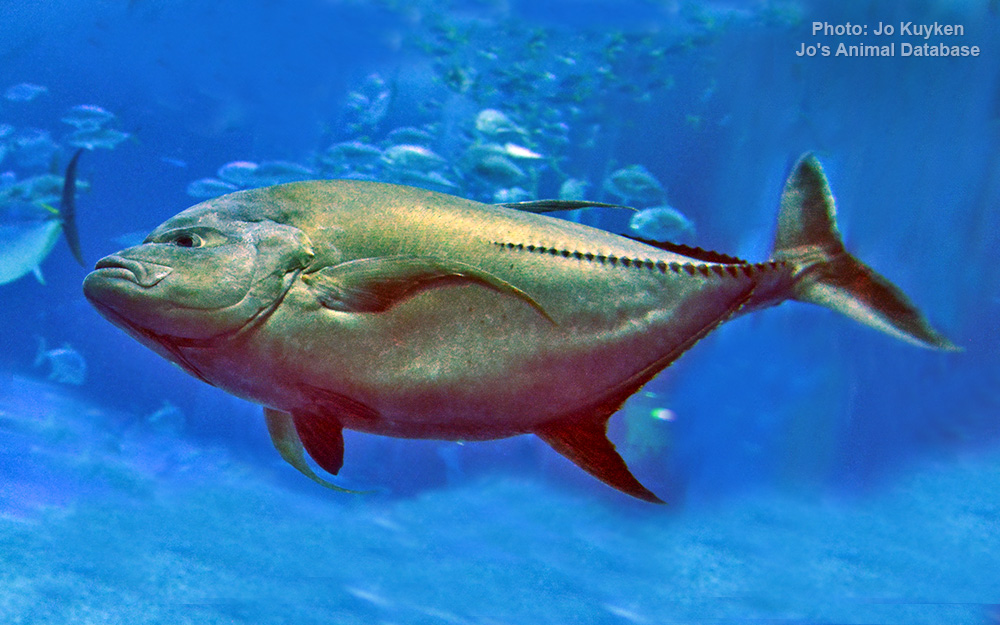Black jack
(Caranx lugubris)

Image source: Jo's Animal Database
Classification
General data
Caranx lugubris, the black jack, black trevally, black kingfish, coal fish or black ulua, is a species of large ocean fish in the jack family Carangidae. The species has a circumtropical distribution, found in oceanic, offshore waters of the tropical zones of the Pacific, Atlantic and Indian Oceans. The species is particularly prevalent around offshore islands such as the Caribbean islands in the Atlantic, Hawaii and French Polynesia in the Pacific and the Seychelles and Maldives in the Indian Ocean.
Black jack are rare in shallow waters, preferring deep reefs, ledges and seamounts in clear waters. The species is easily distinguished by its black to grey fins and jet black scutes, with the head having a steep profile near the snout.
The largest recorded length is 1 m and weight of 17.9 kg.
The black jack lives either individually or in small schools, and is known to school with other species. It is a predatory fish, taking a variety of fish, crustaceans and molluscs as prey. Sexual maturity is reached at 34.6 cm in females and 38.2 cm in males, with spawning taking place between February and September in the Caribbean. The early life history of the species is very poorly understood.
Black jack are of high importance to many island fisheries, but are rarely encountered in most continental fisheries. The species has a reputation as a gamefish, and is variably considered a terrible or excellent food fish, although several cases of ciguatera poisoning have been attributed to the species.
The black jack is a benthopelagic species rarely found in shallow inshore waters, preferring deep, clear offshore waters[15] of depths from 12 to 354 m.[16] The species is most common in insular oceanic habitats and around offshore islands, rarely found close to the continents.[17] The black jack inhabits deep reefs and reef drop offs,[17] also being common around oceanic seamounts.[18][19] It has been recorded from lagoons in the Solomon Islands.[20]
Description
The black jack is a large fish, and is confidently known to grow to a length of 1 m and a weight of 17.9 kg,] although is more common at lengths under 70 cm. At least one source asserts a fish of 2.21 m has been reported, which if true would make the black jack the second largest species of carangid behind the yellowtail amberjack (2.5 m).
The black jack has a similar overall body shape to the other members of Caranx, having an oblong, compressed form, with the dorsal profile more convex than the ventral profile. This convexity is most pronounced at the head, which slopes steeply downwards, giving the head profile a very angular appearance. The profile between the snout and the nape is concave, with this indent centred near the nostrils.
The mouth is fairly large compared to other members of its genus and the maxilla extends to under the centre of the eye.] The upper jaw contains a series of strong outer canines with an inner band of smaller teeth, while the lower jaw contains a single row of widely spaced conical teeth.
The dorsal fin of the black jack is in two sections; the first has 8 spines and the second 1 spine and 20 to 22 soft rays. The anal fin has 2 anteriorly detached spines and 16 to 19 soft rays. The lobes of both the dorsal and anal fins are elongated. The pelvic fins contain 1 spine and 21 soft rays, while the pectoral fins are falcate and longer than the head.
The lateral line has a pronounced and moderately long anterior arch, with the curved section intersecting the straight section below the lobe of the second dorsal fin. The curved section of the lateral line contains around 50 scales[24] while the straight section 26 to 32 strong scutes. The caudal peduncle also has paired bilateral keels. The chest is completely covered in scales, which like the rest of the body are small and cycloid in nature. The species has 23 to 30 gill rakers in total and there are 24 vertebrae present.
The body of the black jack is a uniform olive to brown, grey and even black colour along the back that lightens to a grey-blue near the underside of the fish. The fins are grey to black, and the scutes are black. The upper limit of the operculum often has a small dark spot present, usually smaller than the pupil.












